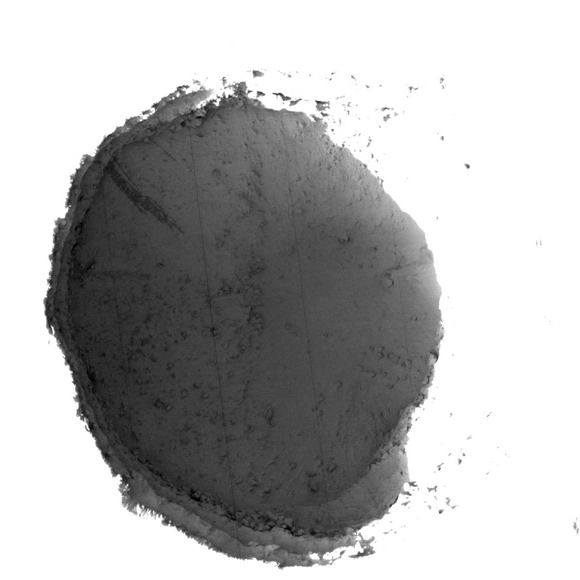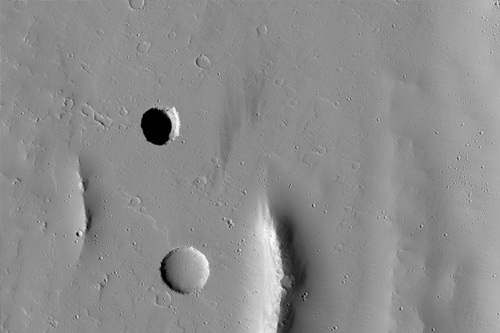[/caption]
Dark pits on Mars are fascinating – probably because they provide mysteries and possibilities. Could anything be inside? Or could this be a place where humans could set up a base since it would provide shelter from Mars’ harsh environment? Some of the pits found earlier have been speculated to be entrances into caves, but more likely this is a collapse pit. Pits like this form by collapse into underground voids, such as those left by propagating magma-filled dikes. The pit in this image has very steep walls, and so only a narrow arc is illuminated by sunlight. The rest of the pit is in dark shadow. However, the HiRISE teams created a stretched version of the image, which shows details of the pit floor, due to a small amount of scattered sunlight. Anything interesting inside?

No, not really; at least with the detail we can see here. The inside of the pit looks much the the surrounding region of Mars, but it could offer a possible habitat for future Mars explorers, even though the pit is quite deep, probably 150 meters (490 feet) deep. This pit is located in Tractus Fossae, a region of large ridges and troughs created by tectonic activity. Sometimes collapse pits may have overhanging walls, although in this case the walls can be seen and appear nearly vertical.
This pit is essentially a vertical shaft cut through the lava flows on the flank of the volcano. Such pits form on similar volcanoes in Hawaii and are called ‘pit craters.’ They generally do not connect to long open caverns but are the result of deep underground collapse.
The fossae, or troughs, occur on the Tharsis volcanic rise, a giant region of enhanced volcanic activity that includes the three large volcanoes Ascraeus Mons, Pavonis Mons and Arsia Mons.
Source: HiRISE


Can we assume the HIRISE team will be targeting all the other dark pits that have been IDd?
“No cavebears so it looks like a good place to live.”
A phrase spoken often over human history.
Talk about an echo chamber- I bet that those little green cave bears only come out at night to chase the elusive Martians who seldom venture to the inhospitable surface-Instead preferring their underworld labyrinths which have been their primary home since the great wars burned off their atmosphere a couple of
billion years ago.
Does anybody have any idea what that dark coloured slip material is, at ten o’clock?….it looks like a slip of darker ‘soil’ that is coming off the bottom of the pit wall…it happens to look somewhat liquidlike ( but obviously its not liquid )
The idea of exploring caves on a distant world? Fun, Fun, Fun!
Are the ground penetrating radars on the Mars Express and MRO missions getting data here?
Better yet: Have they found evidence of subsurface cavities… yet?
Excavate then seal. Cover it with a dome and pressurise.
Ummm … we’re not cave dwellers any more. I’d like to see us build a glass palace there. Get some serious architects involved, go nuts.
Excavate then seal. Cover it with a dome and pressurise.
Better to do that with a normal crater. This will probably have a lot of cave systems to seal off first.
The only morphological difference from what are called circular craters is the depth. Otherwise it’s a circular crater. Since craters on Mars and on all the rocky and icy bodies of the solar system come in a variety of perplexing shapes that one is hard-pressed to attribute to impacts, including polygons and highly irregular shapes, it’s a wonder that a deeper circle gets the attention over examples that are much more mysterious. At the Messenger site, see on Mercury, for example, the precisely straight-edged, 182 km wide crater Praxiteles.
http://messenger.jhuapl.edu/gallery/sciencePhotos/image.php?gallery_id=2&image_id=296
It looks like a scene from Star Wars.
No thanks, not only do you want to be on Mars, but also stuck down a pit 150m deep? Engineering costs would be huge.
But i”d settle for one 10m deep, like Aqua says. Excavate, seal and cover with a dome.
Deep pits like this one would be interesting to investigate. They’re low in elevation, so they should have a higher air pressure than normal. And they’re shielded from the sun’s UV rays because they’re mostly in shade. So the chemical conditions there would be different to the rest of Mars’s surface, and be worth studying.
Originally I thought that dark patch might just be a shadow cast by a ledge inside the crater. Looking at it at 400 and 800% it actually looks more like flowing liquid. Surely not at the bottom of a cold, dark crater. So perhaps it is some crumbly dark material that has fallen off the side of the crater and flowed down towards the centre. Though beyond the dark part there is some hint of lighter coloured flow to the crater centre that- from my liquid world biased view looks like marks left where liquid once flowed.
Of course it might also be a recent slide that has uncovered some fresh dust rather than the dust exposed to the atmosphere.
Why not get HiRise to take an image when the sun is directly overhead and then we will be able to see much more detail.
Just like to say hats off to the HiRise team, the fact that we can take such detailed photos of a dark pit, then process them so that we can see inside the pit just using scattered sunlight is amazing to me.
I feel very lucky to be living now when we are able to explore Mars just by logging onto the internet. Even if we send people there in my lifetime (although I reckon with the 50 odd years I have left we probably will), it is still an immense privilege be part of the exploration of our solar system.
It’s a “sinkhole”.
I live in Florida and Florida is covered with Sinkholes.
1000’s of Floridian lakes, ponds and springs are sinkholes or have sinkholes in them.
In Florida, sinkholes are caused when support between layers of limestone deposits are compromised usually due to a lack or over abundace of water in the aquifure. These cavities can lie dormant for hundreds or thousands of years or can open up with no warning , sometimes swallowing up cars, houses, lakes,pets,etc.
I read a story of a horse being rescued, recently!
The last place I want to be is in a sinkhole or a slow moving two dimensional blackhole.
Some sinkholes can be filled , usually with soil or concrete. Most are too large or too deep.
Some can be hundreds of meters deep!
Add the fact that the Mars holes are located in an area of ridges and troughs, they could be Martian sinkholes.
So the Hollow Earthers were almost right? They just needed to get to the next planet over. Understandable mistake. Happens to all of us at some point.
Now when’ll they start funding expeditions to Mars instead of the Arctic?
Meteors can easily make a hole like this.
When you have light volcanic rock with a porfiric texture with a little bit harder crust the hole beneath is always collapsing.
Vulcanic material is simply ideal for preserving ancient meteor impacts.
Mars is full of it, due to the lack of a thick atmosphere.
100 years from now it’s sealed off with pressurized air, a green landscaped floor and apartments built all the way up the sides, a 22d Century Barsoomian city.
There is a shadow vessel at the bottom “Do Not Disturb it”.
Sci Fi time: Tay, this site is the location of a former landing site, now vacated. Nearby geothermal vents provided power.
We finally send a probe into the chasm. In the bottom we find the remains of collapsed collums and arches from the dome which once covered the site. Upon release of the images to the media, thousands report dreams and memories of being in the dome, being probed and even operated upon by alien beings.
Or maybe naught…. ~@; )
“Why not get HiRise to take an image when the sun is directly overhead and then we will be able to see much more detail.”
Because then HiRISE wouldn’t be directly overhead. The orbit is set up so that it precesses around the planet at the same rate that the planet rotates, and is timed so that daytime observations happen in the afternoon so that there are enough shadows to see things.